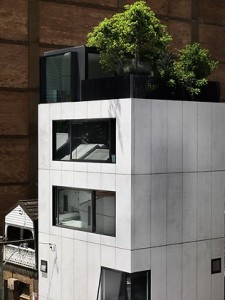by HELEN YOUNG, The Australian, August, 18, 2012

The Small House in Sydeny’s Surry Hills
Photo: Trevor Mein
Source: Supplied via The Australian
Imagine flying over a city where the rooftops below are living green, where plants and even vegetable gardens transform the lost spaces on top of buildings. It’s already happening around the world, and Australia is embracing the trend.
In Sydney’s Pyrmont, we’re standing on the rooftop of a heritage-listed building, surrounded by a vast garden sitting in the sky. M Central is an apartment block whose 2005 resurrection as a hip inner-city residence came a century after its construction as a wool store. Landscape architect Daniel Baffsky of 360 Degrees, who designed the 3000sq m communal garden, says the brief was to surprise rather than “have the ubiquitous pool and huge deck”.
Swaths of native foxtail grass lend an almost rural ambience at one end, their furry plumes swaying with the breeze. Bold succulents give textural contrast, while the centrepiece of a small lawn is a magnificent dragon’s blood tree. On the upper level, vine-covered arbours and wide timber boardwalks, shaded by tall tuckeroo trees, flank a covered events area. The sound of water tinkles gently.
The garden is beautiful, but also a social hub for M Central’s 400 residents, offering opportunities for interaction, from barbecues to dog walking.
“There’s no question about the environmental benefits of green roofs but the social benefits are not yet fully explored. Up on the roof everyone is equal,” Baffsky says.
The burgeoning interest in green roofs is driven by their multiple environmental and social advantages. Greening a city’s roofs is one of the best ways to combat the urban heat island effect (UHIE), a phenomenon that causes significantly higher temperatures in cities compared to rural areas. The accumulation of heat absorbed and generated by buildings, pavements and vehicles is calculated to make a difference of up to 10C. In Melbourne, the UHIE has been determined at a mean of 2-4C and as high as 7C, depending on the time of year and location. Canadian research suggests ambient temperatures could drop by 2C if just 8 per cent of roofs were greened. Reduced rainfall run-off, which feeds to stormwater, and absorption of airborne particle pollution by vegetation are among other environmental benefits.
Energy efficiency is another target area, with green roofs reducing heating and cooling loads through their insulating properties. Internal noise levels are also lowered, of particular benefit near airports. Aesthetically, green space is highly desirable, and there’s a bonus for neighbours who overlook the area. Stylish outdoor living areas are boosting property values and rental appeal, with a growing proportion of new apartment complexes boasting green roof gardens.
Green roofs differ from roof gardens in significant ways, although there are fuzzy boundaries. By definition, green roofs have soil and plants covering most of the roof over specialised waterproofing and drainage layers. In industry parlance, there are two types. “Extensive” green roofs have a thin soil layer, less than 200mm, with low-growing plants requiring minimal maintenance. They can be installed on pitched roofs and are not designed for recreational use. “Intensive” green roofs are flat, with garden bed depths of 200-1500mm to allow for substantial planting, including trees and shrubs. Consequently they require greater structural load bearing, maintenance and irrigation. They’re also designed to be enjoyed.
Germany has been the frontrunner in developing green roofs, dating back to the late 1960s, and now has the world’s greatest number of green roofs. They’re common across Europe, with many cities mandating green roofs in development controls. The US, Canada and Japan are rapidly catching up.
When the Committee for Melbourne’s Future Focus Group launched Growing Up – The Blueprint to Green-Roof Melbourne competition three years ago for retrofitting an existing city rooftop, it attracted about 70 entries. The winner was Bent Architecture for 131 Queen St, a 10-storey office block with a mix of small business tenants. Its design, featuring a central landscaped hill planted with succulents, and a variety of gathering and seating zones, was built at a cost of about $250,000, funded by the project and support from suppliers. The chosen plants survive on natural rainfall, except for a small edibles garden irrigated from a rainwater tank. Merran Porjazoski, principal of Bent Architecture, says, “It’s become an urban backyard for the building.”
Companies such as Fytogreen are at the forefront of the Australian industry. With involvement in more than 112,000sq m of roof gardens over the past 10 years, Fytogreen is the contractor for the Victorian Desalination Project, which at 26,000sq m will be the largest roof garden in the southern hemisphere. Other projects include the Museum of Old and New Art (MONA) in Hobart and the Envirodome roof garden at Adelaide Zoo. Its 10th-floor roof garden at residential tower Freshwater Place in Melbourne’s Southbank covers 2000sq m and includes lush lawns, barbecue areas and views over the Yarra River.
The Small House, in Sydney’s Surry Hills, was built on a footprint of just 46sq m. The home of architect Domenic Alvaro, it was picked as the best house at the 2011 World Architecture Festival awards in Barcelona. “The roof terrace is the fifth room in the house,” Alvaro says. “It was our only opportunity for green space and benefits the street and neighbouring apartments, which now look on to a garden instead of ugly airconditioning equipment.” A large fig tree creates a canopy, while layers of pots support screening and edible plants. As principal of architects Woods Bagot, Alvaro is keen to apply his experience of “extending the green” to commercial residential projects.